Monitor lizard
| Monitor lizard Temporal range:
| |
|---|---|
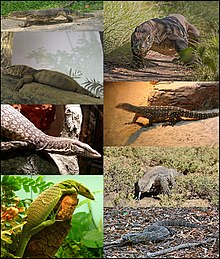
| |
| Left: V. varius
| |
| Scientific classification | |
| Domain: | Eukaryota |
| Kingdom: | Animalia |
| Phylum: | Chordata |
| Class: | Reptilia |
| Order: | Squamata |
| Family: | Varanidae |
| Genus: | Varanus Merrem, 1820 |
| Type species | |
Varanus varius
, 1790 | |
| Subgenera | |
| |
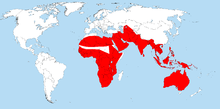
| |
| Combined native range of all the monitor lizards | |

Monitor lizards are lizards in the genus Varanus, the only extant genus in the family Varanidae. They are native to Africa, Asia, and Oceania, and one species is also found in the Americas as an invasive species.[1] About 80 species are recognized.
Monitor lizards have long necks, powerful
Etymology
The
In English, they are known as "monitors" or "monitor lizards". The earlier term "monitory lizard" became rare by about 1920.
In
The West African Nile monitor is known by several names in Yoruba, including awọ́nríwọ́n, awọ̀n, and àlégbà. In Wolof it is known as mbossé or bar, and is the traditional totem of the city of Kaolack.[10]
Due to confusion with the large New World lizards of the family
Distribution
The various species
Habits and diet
Most monitor lizards are almost entirely carnivorous,
Biology
Monitor lizards are considered unique among animals in that its members are relatively morphologically conservative, yet show a very large size range.[18] However, finer morphological features such as the shape of the skull and limbs do vary, and are strongly related to the ecology of each species.[19][20]
Monitor lizards maintain large territories and employ active-pursuit hunting techniques that are reminiscent of similar-sized mammals.
Like snakes, monitor lizards have highly forked tongues that act as part of the "smell" sense, where the tips of the tongue carry molecules from the environment to sensory organs in the skull. The forked apparatus allows for these lizards to sense boundaries in the molecules they collect, almost smelling in "stereo".[23]
Monitor lizards have a high aerobic scope which in turn ensure that oxygenated blood is quickly distributed to the body without also flooding the lungs with high-pressure blood.
Monitor lizards are
Venom
Anatomical and molecular studies indicate that all varanids (and possibly all lizards) are venomous.[28][29] Unlike snakes, monitor lizard venom glands are situated in their lower jaw.[30] The venom of monitor lizards is diverse and complex, as a result of the diverse ecological niches monitor lizards occupy.[31]
For example, many species have anticoagulant venom, disrupting clotting through a combination of fibrinogenolysis and blocking platelet aggregation. Amongst them, arboreal species such as the tree monitors and the banded monitor have by far the strongest fibrinogenolytic venom. As a result, wounds from monitor lizard bites often bleed more than they would if they were simply lacerations. Venom may also cause hypotension.[32]
In some species such as the Komodo dragon and the desert monitor, venom also induces a powerful neurotoxic effect. In the latter species for instance, envenomation causes immediate paralysis in rodents (but not birds) and lesser effects of the same nature in humans.[33]
Intelligence
At least some species of monitors are known to be able to count; studies feeding rock monitors varying numbers of snails showed that they can distinguish numbers up to six.[34][35] Nile monitors have been observed to cooperate when foraging; one animal lures the female crocodile away from her nest, while the other opens the nest to feed on the eggs. The decoy then returns to also feed on the eggs.[34][35] Komodo dragons at the National Zoo in Washington, DC, recognize their keepers and seem to have distinct personalities.[35] Blue and green tree monitors in British zoos have been observed shredding leaves, apparently as a form of play.[36]
Exploitation
As pets

Monitor lizards have become a staple in the
Traditional medicines
Monitor lizards are poached in some South- and Southeast Asian countries as their organs and fat is used in some traditional medicines, although there is no scientific evidence as to their effectiveness.[37][38]
Monitor lizard meat, particularly the tongue and liver, is eaten in parts of India and Malaysia, and is supposed to be an aphrodisiac.[39][40]
In parts of Pakistan and southern India, as well in Northeastern India particularly Assam the different parts of monitor lizards are traditionally used for treating
Consuming raw blood and flesh of monitor lizards has been reported to cause eosinophilic meningoencephalitis, as some monitors are hosts for the parasite Angiostrongylus cantonensis.[39]
Leather
"Large-scale exploitation" of monitor lizards is undertaken for their skins, which are described as being "of considerable utility" in the leather industry.[41] In Papua New Guinea, monitor lizard leather is used for membranes in traditional drums (called kundu), and these lizards are referred to as kundu palai or "drum lizard" in Tok Pisin, the main Papuan trade language. Monitor lizard skins are prized in making the resonant part of serjas (Bodo folk sarangis) and dotaras (native strummed string instruments of Assam, Bengal and other eastern states). The leather is also used in making a Carnatic music percussion instrument called the kanjira.
Food
The meat of monitor lizards is eaten by some tribes in India,[42] Nepal,[43] the Philippines, Australia, South Africa and West Africa as a supplemental meat source.[citation needed] Both meat and eggs are also eaten in Southeast Asian countries such as Vietnam and Thailand as a delicacy.[44]
Conservation
According to
The yellow monitor is protected in all countries in its range except Bhutan, Nepal, India, Pakistan, and Bangladesh.[46]
In Kerala, Andhra Pradesh, Karnataka, Telangana and all other parts of South India, catching or killing of monitor lizards is banned under the Protected Species Act.
Evolution
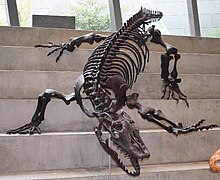
Varanus is the only living genus of the family Varanidae. Varanids last shared a common ancestor with their closest living relatives, earless "monitors", during the Late Cretaceous. The oldest known varanids are from the Late Cretaceous of Mongolia. During the Eocene, the varanid Saniwa occurred in North America. The closest known relative of Varanus is Archaeovaranus from the Eocene of China, suggesting that the genus Varanus is of Asian origin. The oldest fossils of Varanus date to the early Miocene.[47]
Many of the species within the various subgenera also form species complexes with each other:
- V. indicus species complex (
- V. doreanus species complex (V. doreanus, V. finschi, V. semotus, V. yuwonoi)[50]
- V. acanthurus species complex (V. acanthurus, V. baritji, V. primordius, V. storri)
- V. timorensis species complex (V. timorensis, V. auffenbergi, V. scalaris, V. similis, V. tristis)
- V. gouldii species complex (V. gouldii, V. rosenbergi, V. panoptes)
- V. exanthematicus species complex (V. exanthematicus, V. albigularis, V. yemenensis)
- V. niloticus species complex (V. niloticus, V. stellatus)
- V. bengalensis species complex (V. bengalensis, V. nebulosus)
- V. salvator species complex (V. salvator, V. cumingi, V. nuchalis, V. togianus, V. marmoratus)[51][48][52][53][54]
The tree monitors of the V. prasinus species complex (
V. jobiensis was once considered to be a member of the V. indicus species complex, but is now considered to represent its own species complex.[50]
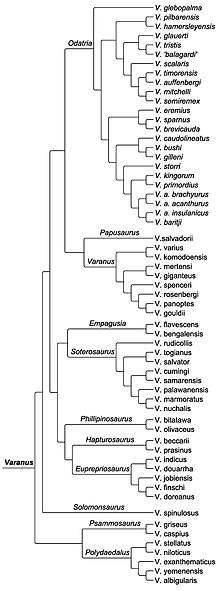
|
Taxonomy


Genus Varanus
- Species marked with † are extinct
- †V. bolkayi[56]
- †V. darevskii[57][58]
- †V. emeritus (=V. salvadorii?)[56]
- †V. hooijeri[56]
- †V. hofmanni[56]
- †V. lungui[56]
- †V. marathonensis
- †V. mokrensis[59]
- †V. pronini[56]
- †V. rusingensis[56][59]
- †V. semjonovi[56]
- †V. tyrasiensis (=V. hofmanni?)[56]
Subgenus

- V. bengalensis, Bengal monitor
- V. dumerilii, Dumeril's monitor, brown roughneck monitor
- V. flavescens, golden monitor, yellow monitor, short-toed monitor
- V. nebulosus, clouded monitor
- V. rudicollis, black roughneck monitor


Subgenus Euprepiosaurus:[60]
- V. bennetti, Bennett's long-tailed monitor[61]
- V. caerulivirens, turquoise monitor
- V. cerambonensis, Ceram monitor
- V. colei Kei Islands monitor[49]
- V. doreanus, blue-tailed monitor
- V. douarrha, New Ireland monitor
- V. finschi, Finsch's monitor
- V. indicus, mangrove monitor
- V. jobiensis, peach-throated monitor
- V. juxtindicus, Rennell Island monitor
- V. lirungensis, Talaud mangrove monitor
- V. louisiadensis, Louisiade monitor[62]
- V. melinus, quince monitor[63]
- V. obor, sago monitor
- V. rainerguentheri Rainer Günther's monitor
- V. semotus, Mussau Island blue-tailed monitor[64]
- V. tanimbar, Tanimbar monitor[62]
- V. tsukamotoi, Mariana monitor[61]
- V. yuwonoi black-backed mangrove monitor, tricolor monitor
- V. zugorum, silver monitor, Zug's monitor
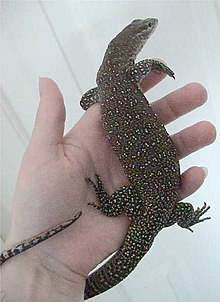
Subgenus Hapturosaurus:[50]
- V. beccarii, black tree monitor
- V. boehmei, golden-spotted tree monitor
- V. bogerti, Bogert's monitor
- V. keithhornei, canopy goanna, blue-nosed tree monitor, Nesbit River monitor[65]
- V. kordensis, Biak tree monitor
- V. macraei, blue-spotted tree monitor
- V. prasinus, emerald tree monitor[66]
- V. reisingeri[67] yellow tree monitor
- V. telenesetes, mysterious tree monitor, Rossell tree monitor



Subgenus Odatria:
- V. acanthurus, spiny-tailed monitor, ridge-tailed monitor, Ackie's dwarf monitor
- V. a. acanthurus, spiny-tailed monitor
- V. a. brachyurus, common spiny-tailed monitor
- V. auffenbergi, Auffenberg's monitor, peacock monitor
- V. brevicauda, short-tailed monitor
- V. bushi, Pilbara stripe-tailed monitor, Bush's monitor
- V. caudolineatus, stripe-tailed monitor
- V. citrinus, Gulf ridge-tailed monitor[68]
- V. eremius, rusty desert monitor, pygmy desert monitor
- V. gilleni, pygmy mulga monitor
- V. glauerti, Kimberley rock monitor
- V. glebopalma, twilight monitor, black-palmed rock monitor
- V. hamersleyensis, Hamersley Range rock monitor
- V. insulanicus, Groote Eylandt monitor[68]
- V. i. baritji, black-spotted ridge-tailed monitor
- V. kingorum, Kings' rock monitor
- V. mitchelli, Mitchell's water monitor
- V. ocreatus, Storr's monitor[68]
- V. pilbarensis, Pilbara rock monitor
- V. primordiusnorthern blunt-spined monitor
- V. scalaris, banded tree monitor
- V. semiremexrusty monitor
- V. similis, Similis monitor, spotted tree monitor
- V. sparnus, Dampier Peninsula monitor
- V. storri, eastern Storr's monitor
- V. timorensis, Timor monitor
- V. tristis
- V. t. tristis, black-headed monitor
- V. t. orientalis, freckled monitor
Subgenus
- V. salvadorii, crocodile monitor
Subgenus Philippinosaurus:
- V. bitatawa, northern Sierra Madre forest monitor, butikaw, bitatawa
- V. mabitang, Panay monitor, mabitang
- V. olivaceus, Gray's monitor, butaan


Subgenus Polydaedalus:
- V. albigularis, rock monitor, white-throated monitor
- V. a. albigularis, white-throated monitor
- V. a. angolensis, Angolan monitor
- V. a. microstictus, black-throated monitor
- V. exanthematicus, savannah monitor, Bosc's monitor
- V. niloticus, Nile monitor
- V. stellatus, West African Nile monitor
- V. ornatus, ornate monitor
- V. yemenensis, Yemen monitor


Subgenus Psammosaurus:
- V. griseus, desert monitor
- V. g. griseus, desert monitor, grey monitor
- V. g. caspius, Caspian monitor
- V. g. koniecznyi, Indian desert monitor, Thar desert monitor
- V. nesterovi, Nesterov's desert monitor
Subgenus
- V. spinulosus, spiny-necked mangrove monitor, Solomon Islands spiny monitor
Subgenus Soterosaurus:
- V. bangonorum, Bangon monitor[70]
- V. cumingi, Cuming's water monitor, yellow-headed water monitor
- V. dalubhasa, Enteng's monitor[70]
- V. marmoratus, marbled water monitor, Philippine water monitor
- V. nuchalislarge-scaled water monitor
- V. palawanensis, Palawan water monitor
- V. rasmusseni[71][72] Rasmussen's water monitor
- V. salvator, Asian water monitor
- V. s. salvator, Sri Lankan water monitor
- V. s. andamanensis, Andaman water monitor
- V. s. bivittatus, two-striped water monitor, Javan water monitor
- V. s. macromaculatus, Southeast Asian water monitor
- V. s. ziegleri, Ziegler's water monitor
- V. samarensis, Samar water monitor
- V. togianus, Togian water monitor

Subgenus Varanus:
- V. giganteus, perentie
- V. gouldii, Gould's monitor, sand monitor, sand goanna
- V. komodoensis, Komodo dragon
- V. mertensi, Mertens' monitor
- V. panoptes
- V. p. panoptes, Argus monitor
- V. p. horni, Horn's monitor
- V. p. rubidus, yellow-spotted monitor
- †V. priscus, megalania
- V. rosenbergi, Rosenberg's monitor, heath monitor
- V. spenceri, Spencer's monitor
- V. varius, lace monitor
Gallery
-
Unknown species lizard inRaja AmpatPapua, 2016
-
Varanus jobiensisin Raja Ampat Papua, 2017
-
Varanus jobiensis in Raja Ampat Papua, 2017
References
- ^ "Monitor | lizard | Britannica". www.britannica.com. 2023-05-23. Retrieved 2023-06-06.
- ISBN 0-12-178560-2.
- ^ ISBN 0-86622-634-6.
- ^ Google ngrams
- Horatio Nelson, Matthew Henry Barker, The Life of Nelson Revised and Illustrated. With Original Anecdotes, Notes, Etc. By the Old Sailor, 1836 p. 35
- OCLC 697605207.
- ^ Blust, Robert; Trussel, Stephen (2010). "*bayawak: monitor lizard, Varanus spp. (esp. V. salvator)". Austronesian Comparative Dictionary. Max Planck Institute for Evolutionary Anthropology. Retrieved January 30, 2022.
- ^ Mark K. Bayless (2004). "The local names of Pacific monitor lizards (Sauria: Varanidae) of Oceania & Indo-Malaysia, excluding Australia" (PDF). Micronesia. 37 (1): 49–55.
- ^ Maren Gaulke (1992). "Taxonomy and biology of Philippine water monitors (Varanus salvator)". The Philippine Journal of Science. 121 (4): 345–381.
- ISBN 9782865379040.
- ^ Yong, Ed (20 April 2016). "Florida's Dragon Problem". The Atlantic.
- S2CID 90865661.
- ^ Pianka, Eric R.; King, Dennis R; King, Ruth Allen (2004). Varanoid Lizards of the World. Bloomington, Indiana: Indiana University Press.
- ^ Auffenberg, Walter (1981). The Behavioral Ecology of the Komodo Monitor. University Press of Florida.
- OL 7155983M.
- PMID 20375042.
- S2CID 12091969.
- S2CID 85237692.
- PMID 26106889.
- .
- ^ King, D., Green, B., Knight, F. (1999). Monitors: The Biology of Varanid Lizards. Florida. Krieger Publishing Company.
- ^ a b c Pianka, E.R., Vitt, L.J. (2003). Lizards: Windows to the Evolution of Diversity. California. University of California Press.
- S2CID 251407423.
- S2CID 19320799.
- ^ PMID 14581594.
- ^ https://indonesiaindonesia.com/f/37477-sejarah-pulau-komodo/ (in Indonesian)
- S2CID 191590714. Retrieved 2006-12-20.
- ^
Fry BG, Wroe S, Teeuwisse W, van Osch JP, Moreno K, Ingle J, McHenry C, Ferrara T, Clausen P, Scheib H, Winter KL, Greisman L, Roelants K, van der Weerd L, Clemente CJ, Giannakis E, Hodgson WC, Luz S, Martelli P, Krishnasamy K, Kochva E, Kwok HF, Scanlon D, Karas J, Citron DM, Goldstein EJ, Mcnaughtan JE, Norman JA (June 2009). "A central role for venom in predation by Varanus komodoensis (Komodo dragon) and the extinct giant Varanus (Megalania) priscus". PNAS. 106 (22): 8969–8974. PMID 19451641.
- ^
Fry BG, Vidal N, Norman JA, Vonk FJ, Scheib H, Ramjan SF, Kuruppu S, Fung K, Hedges B, Richardson MK, Hodgson WC, Ignjatovic V, Summerhays R, Kochva E (February 2006). "Early evolution of the venom system in lizards and snakes". Nature. 439 (7076): 584–588. S2CID 4386245.
- PMID 19451641.
- PMID 31067768.
- PMID 31067768.
- ^ Zima, Yuliya (December 2019). "On the Toxicity of the Bite of the Caspian Gray Monitor Lizard (Varanus griseus caspius)". Biawak. 13 (2): 115–118 – via ResearchGate.
- ^ ISBN 0-86840-456-X, p. 43.
- ^ a b c Pianka, E.R.; King, D.R. and King, R.A. (2004). Varanoid Lizards of the World. Indiana University Press.
- .
- ^ "How Lizard Genitalia Became a Black Market Craze". National Geographic Society. 7 July 2017. Archived from the original on March 3, 2021.
- ^ "Visakhapatnam: Monsoon activates monitor lizard poaching". 4 July 2017.
- ^ .
- ^ Eating Biawak. The Malaysian Life (April 2009)
- ^ ISSN 2347-2677. Retrieved 12 December 2013.
- ^ "Meats We Also Eat". The Telegraph India. 2017-01-08. Archived from the original on August 12, 2018. Retrieved 2018-08-12.
- .
- ^ Side, Sonny (5 June 2019). "Eating a DINOSAUR in Asia!!! RARE Mekong Delta Food you will only find here!". Archived from the original on 2021-11-07 – via YouTube.
- ^ "Identification Guides for Wildlife Traded in Southeast Asia". ASEAN-WEN. 2008.
- ^ Ghimire HR, Shah KB (2014). "Status and habitat ecology of the Yellow Monitor, Varanus flavescens, in the Southeastern part of Kanchanpur District, Nepal" (PDF). Herpetological Conservation and Biology. 9 (2): 387–393.
- PMID 35125002.
- ^ a b "Recommendations of the Nomenclature Committee". 1997-03-07. Archived from the original on 2008-05-18.
- ^ S2CID 213867767.
- ^ .
- ^ BÖHME, WOLFGANG (2003). "Checklist of the living lizards of the world (family Varanidae)". Zool. Verh. Leiden. 341.
- ^ Koch, Andre (2010). "Updated checklist of the living monitor lizards of the world (Squamata: Varanidae)". Bonn Zoological Bulletin. 57: 127–136.
- .
- ^ Mendyk, Robert (2018). "An Annotated Bibliography of Captive Reproduction in Monitor Lizards (Varanidae: Varanus). Part III. Soterosaurus". Biawak. 12.
- S2CID 211297088.
- ^ ISBN 978-0-253-34366-6.
- ISBN 978-0-253-34366-6.
- PMID 30517172.
- ^ S2CID 73543240.
- ^ Ziegler, Thomas; Schmitz, Andreas; Koch, Andre; Böhme, Wolfgang (2007). "A review of the subgenus Euprepiosaurus of Varanus (Squamata: Varanidae): morphological and molecular phylogeny, distribution and zoogeography, with an identification key for the members of the V. indicus and the V. prasimus species groups". Zootaxa 1472: 1-28.
- ^ PMID 32537217.
- ^ .
- .
- PMID 27103877.
- ^ Varanus keithhornei, The Reptile Database
- ^ Varanus prasinus, The Reptile Database
- ^ Eidenmüller, Bernd; Wicker, Rudolf (2005). "Eine weitere neue Waranart aus dem Varanus prasinus-Komplex von den Insel Misol, Indonesian ". Sauria 27 (1): 3-8. (Varanus reisingeri, new species). (in German).
- ^ S2CID 248807709.
- PMID 27615821.
- ^ a b Brendan M. Lynch (2015-01-12). "Undercover researchers expose two new species of lizard for sale on Philippine black market". KU Today. KU | The University of Kansas.
- ^ Koch, André; Gaulke, Maren; Böhme, Wolfgang (2010). "Unravelling the underestimated diversity of Philippine water monitor Lizards (Squamata: Varanus salvator complex), with description of two new species and a new subspecies". Zootaxa 2446: 1-54. (Varanus rasmusseni, new species, p. 28).
- ^ Varanus rasmusseni, The Reptile Database
Further reading
- Merrem B (1820). Versuchs eines Systems der Amphibien: Tentamen Systematis Amphibiorum. Marburg: J.C. Krieger. xv + 191 pp. + one plate. (Varanus, new genus, p. 58). (in German and Latin).
External links
 Data related to Monitor lizard at Wikispecies
Data related to Monitor lizard at Wikispecies Media related to Varanus at Wikimedia Commons
Media related to Varanus at Wikimedia Commons- Western Australian Museum photos
- Scientific American article



